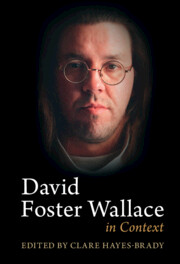Book contents
- David Foster Wallace in Context
- David Foster Wallace in Context
- Copyright page
- Contents
- Figures
- Contributors
- Acknowledgments
- Abbreviations
- Introduction
- Part I Contexts
- Chapter 1 David Foster Wallace and Narratology
- Chapter 2 A Meeting of Minds
- Chapter 3 Writing in a Material World
- Chapter 4 Confidence Man
- Chapter 5 David Foster Wallace and European Literature
- Chapter 6 David Foster Wallace and Poetry
- Chapter 7 David Foster Wallace’s “Non”-Fiction
- Chapter 8 “Thanks Everybody and I Hope You Like It”
- Chapter 9 David Foster Wallace and Visual Culture
- Part II Ideas
- Part III Bodies
- Part IV Systems
- Works by David Foster Wallace
- Bibliography of Secondary Sources
- Index
Chapter 1 - David Foster Wallace and Narratology
from Part I - Contexts
Published online by Cambridge University Press: 18 November 2022
- David Foster Wallace in Context
- David Foster Wallace in Context
- Copyright page
- Contents
- Figures
- Contributors
- Acknowledgments
- Abbreviations
- Introduction
- Part I Contexts
- Chapter 1 David Foster Wallace and Narratology
- Chapter 2 A Meeting of Minds
- Chapter 3 Writing in a Material World
- Chapter 4 Confidence Man
- Chapter 5 David Foster Wallace and European Literature
- Chapter 6 David Foster Wallace and Poetry
- Chapter 7 David Foster Wallace’s “Non”-Fiction
- Chapter 8 “Thanks Everybody and I Hope You Like It”
- Chapter 9 David Foster Wallace and Visual Culture
- Part II Ideas
- Part III Bodies
- Part IV Systems
- Works by David Foster Wallace
- Bibliography of Secondary Sources
- Index
Summary
David Foster Wallace’s challenge as a writer was to try and square the circle of conjugating the legacy of (what was still vital about) postmodernism with the necessity to achieve truthfulness. What narratological shape does this post-ironist challenge take? Drawing on specific examples from his works, such as the jumbled chronology and the consistent employment of the present tense in “Little Expressionless Animals,” the utilization of what I call “figural sliding” in Infinite Jest, the double internal focalization in “Think,” the reorganization of deictic centers due to the metaleptic transgression in “Good Old Neon” and “PopQuiz #9,” this chapter shows how traditional narratological items were reinvented by Wallace to serve his thematic postindustrial concerns and to honor his ever-present need to connect with his readers. Unnatural narratology comes immediately to mind, and yet his pervasive attention to the reader invites us to employ an enactivist lens, thus focusing on the situated and embodied dimensions of the reading activity.
Wallace tends to put his readers in interpretive positions that baffle easy solutions: Narrators are simultaneously omniscient and limited, both “down here quivering in the mud of the trench” and Olympically coordinating “the whole campaign”; focalizing perspectives are fluid and overlapping; the distinction between story and discourse becomes permeable, and so forth. This contribution aims at mapping the (sometimes unnatural) trajectories of Wallace’s narratological reinterpretations while showing how readers negotiate (or fail to negotiate) textual clues starting from their experiential background and their embodied and situated positioning.
- Type
- Chapter
- Information
- David Foster Wallace in Context , pp. 15 - 25Publisher: Cambridge University PressPrint publication year: 2022

